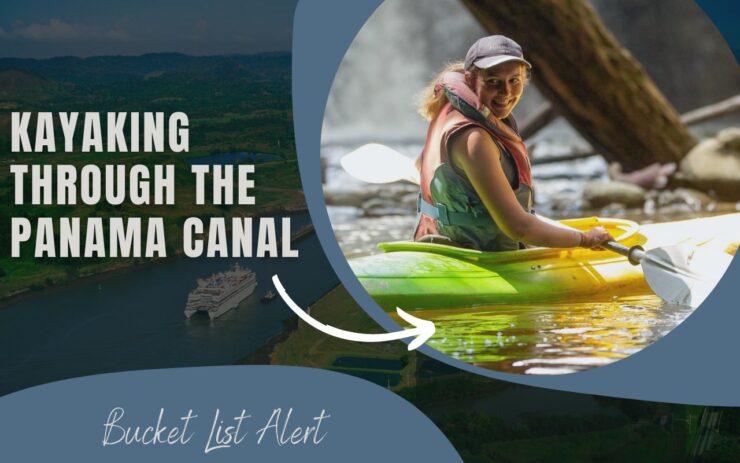This iconic waterway, connecting the Atlantic and Pacific Oceans, has long been a topic of interest for adventurers and travelers alike. But have you ever wondered if it’s possible to kayak through this iconic waterway?
While it might sound like a daring endeavor, this is an achievable and unforgettable experience!
Table of Contents
ToggleWas it always possible?
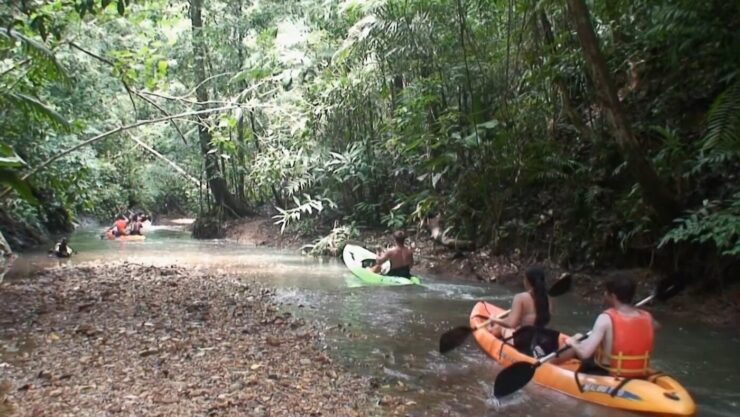
The Panama Canal, stretching 50 miles across the narrowest part of the Central American isthmus, has a rich history that dates back to the early 16th century.
Originally conceived by the Spanish explorer Vasco Núñez de Balboa, the idea of creating a waterway to connect the Atlantic and Pacific Oceans was revolutionary.
Early Exploration and Attempts
The early exploration of the canal began with the Spanish, who saw the potential of a shortcut that would eliminate the treacherous journey around the tip of South America.
However, the dense jungles, malaria, and yellow fever ruined their efforts, leading to the abandonment of the project.
The French and American Endeavors
In the late 19th century, the French, led by Ferdinand de Lesseps—the architect behind the Suez Canal—made their attempt. Despite their engineering prowess, they faced insurmountable challenges, including disease and financial troubles.
It wasn’t until the early 20th century that the Americans, under President Theodore Roosevelt, took over and successfully completed the canal in 1914.
The Modern Canal and Its Operations
Today, the Panama Canal stands as a testament to human ingenuity and perseverance. It serves as a major shipping route, accommodating vessels from small boats to massive container ships.
But how does it operate, and what would a kayaker need to know?
The Lock System
The canal’s lock system is a marvel of engineering. These locks raise and lower ships to the level of Gatun Lake, allowing them to traverse the canal. For kayakers, understanding the operation of these locks is crucial.
While they are primarily designed for larger vessels, with proper planning and permissions, a kayak could potentially navigate through.
Transit Scheduling and Fees
Transiting the canal isn’t free, and there’s a schedule to adhere to. Larger ships pay hefty fees, sometimes in the hundreds of thousands of dollars, for the privilege.
For smaller vessels, including kayaks, the fees are significantly lower, but there’s still a process to follow. Kayakers would need to be aware of transit times and ensure they don’t impede the progress of larger vessels.
What Are The Potential Challenges?
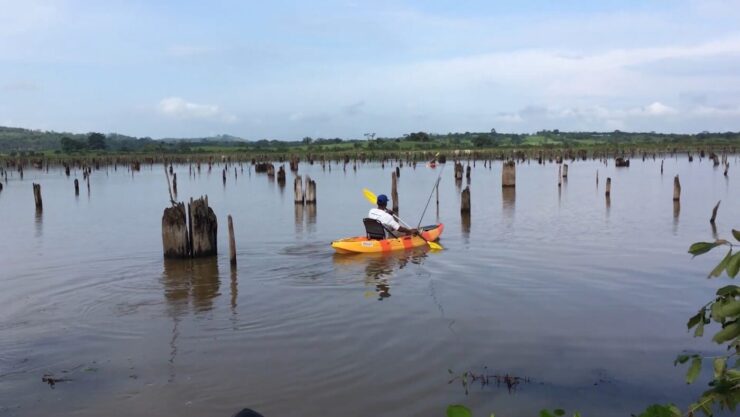
While the idea of kayaking through this area, it’s not without its challenges. From navigating the lock system to ensuring safety amidst massive ships, a kayaker would need to be well-prepared. However, the rewards are unparalleled.
Navigational Challenges
The primary challenge is navigation. The canal is busy, with ships coming and going at all hours. Kayakers would need to be vigilant, ensuring they stay out of the way of larger vessels.
Additionally, understanding the lock system and how to navigate it in a kayak is crucial.
The Reward? Experience of a Lifetime!
For those who rise to the challenge, the experience is unparalleled. Imagine paddling through this historic waterway, surrounded by lush rainforests, with the knowledge that you’re traversing a path that has shaped global trade and travel.
The sense of accomplishment, combined with the breathtaking scenery, makes it a once-in-a-lifetime adventure.
How to Prepare Yourself for this Adventure?
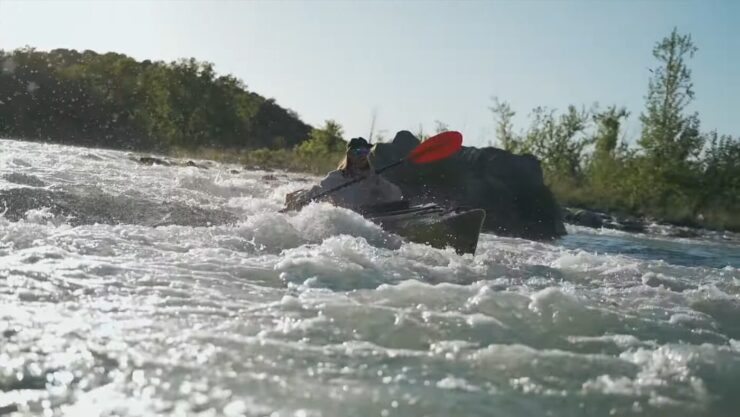
This journey requires careful preparation. From obtaining the necessary permits to ensuring you have the right equipment, every detail matters.
Secure Permits and Permissions!
Before setting out, one must secure the necessary permits from the Panama Canal Authority. This involves submitting an application detailing your intended route, dates of transit, and other relevant information.
It’s essential to start this process well in advance, as approval can take time and there are limited slots available for smaller vessels.
Essential Gear and Equipment
It is essential to make sure you have the right gear.
| Equipment | Description and Purpose |
|---|---|
| Kayak | Sturdy vessel for navigating the canal’s waters. |
| Paddle | Quality paddle for efficient and comfortable paddling. |
| Life Jacket (PFD) | Mandatory flotation device for safety. |
| Communication Device | Waterproof VHF radio or phone case for emergency contact. |
| Navigation Tools | GPS, map, and compass for accurate route tracking. |
| Safety Whistle | Signals for attention or assistance. |
| Signal Lights | White light for visibility during low-light conditions. |
| Waterproof Bag/Dry Bag | Keeps essentials dry and protected. |
| Sun Protection | Hat, sunglasses, and sunscreen to guard against the sun. |
| Hydration and Snacks | Water and energy-rich snacks for sustenance. |
| First Aid Kit | Basic medical supplies for minor injuries. |
| Clothing | Moisture-wicking attire appropriate for the climate. |
| Footwear | Closed-toe water shoes or grippy sandals. |
| Tow Rope | Assists in towing or aiding other kayakers. |
| Repair Kit | Tools and materials for minor kayak repairs. |
| Extra Paddle | Spare paddle in case of paddle loss or damage. |
| Personal Identification | Copy of ID and permits in waterproof container. |
Tips for a Successful Journey
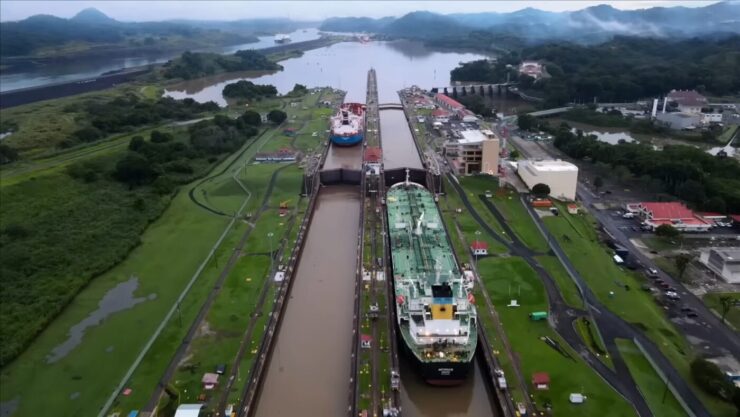
Embarking on a kayaking adventure through the Panama Canal is no small feat. It requires careful planning, adherence to rules, and a spirit of adventure. To be sure that you are well informed before your trip, follow Panamatoday for regular updates.
Here are some valuable tips to ensure a successful and enjoyable journey.
Familiarize Yourself With The Rules and Regulations
The Panama Canal operates under strict rules and regulations to ensure the smooth flow of traffic and the safety of all vessels. Familiarizing yourself with these rules is paramount.
This includes understanding the right of way, signaling protocols, and restrictions within certain areas of the canal. Abiding by these rules ensures a safe transit and shows respect for the canal’s operations.
Weather Considerations
The tropical climate of Panama means that weather can be unpredictable. Understanding the seasonal patterns, monitoring weather forecasts, and being prepared for sudden changes is essential.
Packing rain gear, sun protection, and understanding how weather can affect the water conditions will help you navigate any unexpected weather changes.
Health and Safety Precautions

Your health and safety are paramount when undertaking such an adventurous journey. From potential health risks to ensuring personal safety amidst large vessels, here’s what you need to know.
Vaccinations and Health Precautions
Before embarking on the journey, consult with a healthcare provider about necessary vaccinations and health precautions.
Malaria and yellow fever were once major concerns in the region, and while they are largely controlled now, taking preventive measures is wise.
Also, ensure you have medications for any personal health conditions, as access to medical facilities may be limited during the journey.
Safety Amidst Large Vessels
Navigating a kayak amidst large vessels can be intimidating and risky. Maintaining a safe distance, using proper signaling devices, and wearing bright clothing to increase visibility are essential.
Coordination with the canal’s traffic control and understanding the schedules of larger vessels will help you plan your journey safely.
FAQs
How much is the toll fee?
The toll fee is $45,000.
Can you pay the toll fee with a credit card?
Yes, but the canal authorities might initially request the payment in quarters.
How many ships are allowed to cross the canal each day?
An average of 37 ships a day, but the authorities might claim only 25 ships are allowed.
Is it possible to kayak through the canal year-round?
Yes, but the rainy season in Panama starts in April-May and ends by November-December, which might affect the water levels.
Where can you start your adventure?
The tour typically begins by picking up guests at Panama City and driving along the Panama Canal, passing by Miraflores and Pedro Miguel locks, and arriving at Gamboa Public Ramp.
The Bottom Line
The idea of kayaking through the Panama Canal might seem daunting, but with the right preparation, respect for its operations, and an open heart, it’s an adventure of a lifetime.
It’s a journey that offers amazing experiences, from witnessing engineering marvels to connecting with nature and local communities.
As the saying goes, “It’s not the destination but the journey that matters.” And in the case of the Panama Canal, the journey is truly extraordinary.
Related Posts:
- 16 Best Kayak For Beginners 2025 - Kayaking Adventure Gear
- Heavy Duty Fishing: 11 Best Rods And Reels For Big Fish 2025
- 10 Best Inflatable Kayak 2025 - Rivers, Lakes & Open Seas
- 12 Best Motorized Kayak 2025 - Start Your Aquatic Adventure!
- 10 Best Kayaks For Camping 2025 - Lightweight and…
- 12 Best Truck Bed Hitch Extenders for Kayak 2025 -…

